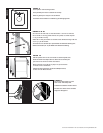
BASIC CONNECTION
FOR RT
i SERIES LOUDSPEAKERS
[FIGURE 4]
Follow the hookup directions included with your receiver. Strip 1/2 inch (12.7mm) of insulation
from each of the two conductors of the wire to expose the bare metal and twist each of the
individual conductors into single unfrayed strands. Note that one of the terminals on the rear of
each speaker is red (+) and the other is black (-). Make certain that you connect the wire from the
red (+) terminal of your amplifier or receiver to the red (+) terminal on your speaker and the wire
from the black (-) terminal of your amplifier or receiver to the black (-) terminal on your speaker.
Most wire has some indicator (such as color-coding, ribbing or writing) on one of the two
conductors to help you maintain consistency.
To connect wire to the binding post
[figure 5], unscrew the hex nut and insert the bare wire into
the hole near the base of the binding post. Do not insert the insulated part of the wire into the hole
as this will not give you a good connection. Twist the hex nut back down the binding post until it
firmly meets the wire. Do not over tighten.
To Use Banana Plugs (US Only): Screw down the binding post nuts all the way. Use a sharp
knife or other sharp tool to pry the colored plastic insert out of the center of the post to expose the
bananana-plug hole.
BI-WIRING AND BI-AMPING
FOR RT
i SERIES LOUDSPEAKERS [RTi70 ONLY]
If you decide to bi-wire or bi-amp, you must remove the flat metal jumpers
between terminal posts. Failure to do this could result in damage to your amplifier
and loudspeakers.
Bi-wiring [figure 6]
can provide noticeable improvements in the overall transparency of your
loudspeakers. Run separate speaker wires to the low and high frequency drivers from a single
amplifier: after removing the jumpers, connect one set of speaker wires to the upper terminals on
each speaker and one set of (usually heavier gauge) wires to the lower terminals. Connect the
other ends of both wire sets to the corresponding amplifier outputs.
Bi-amping [figure 7] allows you to use separate amplifiers for the high and low frequency
sections of your loudspeaker for greater dynamic range and lower distortion. After removing the
jumpers, connect the speaker wires from the high frequency amplifier outputs to the upper set of
terminal posts on each speaker. Follow the same procedure for connecting the low frequency
amplifier outputs to the lower set of terminals. Remember to maintain correct wiring polarity
(+ to +, - to -) in all connections.
FOR MANUAL UPDATES, VISIT
http://www.polkaudio.com/home/library/manuals.php
FOR MORE DETAILED HOOK-UP AND PLACEMENT INFORMATION, VISIT
http://www.polkaudio.com/home/faqad/
FOR RECOMMENDED ACCESSORIES (INCLUDING SPEAKER STANDS, BRACKETS AND
EXCLUSIVE POLK AUDIO LOGOWEAR), VISIT OUR WEBSTORE:
http://shop.polkaudio.com/
Contact Polk Audio Customer Service 1-800-377-7655 (Outside US & Canada: 410-358-3600), polkcs@polkaudio.com










